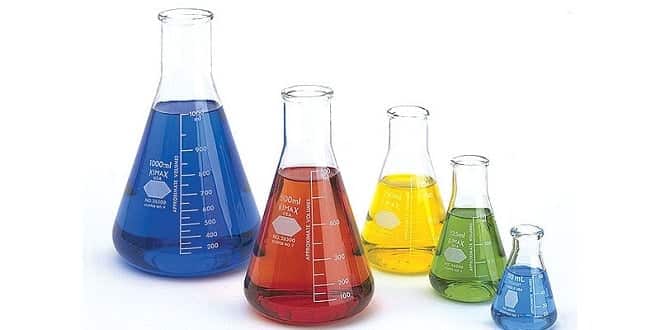Experiment-7 , 8
FE 211 23.11.2004
EXPERIMENT 7- 8
LAB REPORT
Submitted By : Mutlu DEMİREL Group: 3
MATERIALS :
Distilled water , , , , Volumetric Flask , Erlenmayer Flask , KI , HCI , , , KSCN , , starch , burette , graduated cylinder , florence flask , pipette
PURPOSE AND THEORY :
Determination of copper in a sample by iodometry and determination of oxygen in water by iodometry.
METHOD:
Iodometry method.
THEORY:
• Iodometry: starch added only immediately before the equivalence point. Titration is then continued until the blue disappears
• Iodimetry: starch added at the beginning
The iodine (triiodide) – iodide redox system, I3 oxidizing agent. On the other hand, iodide ion can be a strong reducing agent. Analytical reactions using iodine as the oxidizing agent are called iodimetry while procedures using iodide ion as the reducing agent are called iodometry. Since triiodide is such a weak reducing agent, there are few iodimetric determinations of analytical interest. Iodide ion is a strong enough a reducing agent that many oxidizing agents can react completely with the iodide ion resulting in many useful iodometric processes. The usual procedure involves the addition of an excess of iodide ion to the oxidizing agent analyte which produces iodine, which can be titrated with standard sodium thiosulfate solution. The iodine-thiosulfate reaction is quite fast and the equilibrium is far to the product side. Iodine is slightly soluble in water (0.00134 mol/L at 25 oC but is soluble in solutions containing iodide ion. Iodine forms the triiodide complex with iodide, I2 + II3 with an equilibrium constant greater than 500 at 25 oC. Normally, excess potassium iodide is added to the reaction mixture to increase the solubility of iodine and to decrease its volatility. It is possible to prepare primary standard iodine solutions by direct weighing.
Sodium Thlosulfate
Sodium thiosulfate is commonly used as the pentahydrate, Na2S2O3•5 H2O, and
+ 2 e- 3 I- – , is a weak
solutions are standardized against a primary standard. Thiosulfate solutions are not
stable over long periods of time, and frequently borax or sodium carbonate is added
as a preservative. Iodine oxidizes thiosulfate to the tetrathionate ion:
I2 + 2 S2O3
The reaction of iodine with thiosulfate is fast and goes to completion. The equivalent weight of Na2S2O3•5 H2O is the molecular weight, 248.17, since one electron per molecule is lost. Iodine is rarely used as a primary standard for thiosulfate because it presents a problem in weighing and maintaining its solution concentration. Both potassium bromate and potassium iodate oxidize iodide quantitatively to iodine in acid solution:
+ 5 I- IO3 – + 6 I- BrO3 –
The bromate reaction is slow but can be speeded up by increasing the hydrogen ion concentration. The iodate reaction is rapid and it requires only a slight excess of hydrogen ions for complete reaction. The main disadvantage of these two salts being used as primary standards is that their equivalent weights are quite small. In both cases the equivalent weight is one-sixth of the molecular weight. Pure copper is used as a primary standard for sodium thiosulfate and is recommended when the thiosulfate is to be used for the determination of copper. Upon addition of excess iodide to a solution of Cu(II), a precipitate of CuI is formed along with I2. The liberated iodine is then titrated with standard sodium thiosulfate.
+ 4 I- 2 Cu2+ I2 + 2 S2O3
Formation of the precipitate and the addition of excess iodide forces the equilibrium to the right. The pH of the solution must be maintained between pH 3 and 4 by the addition of a buffer. It has been found that iodine is adsorbed onto the surface of the copper(I) iodide precipitate and must be displaced to obtain correct results. Potassium thiocyanate is usually added just before the end point is reached to displace the adsorbed iodine. Note that the net stoichiometry of the react is 1:1 since 2 moles of copper requires 2 moles of thiosulfate.
PROCEDURES:
15 mL of Cu containing sample was diluted to 50 mL. Then 1 mL and 4 gr KI was added to it. The solution was titrated with thiosulfate .During the titration 2 gr KSCN and 5 mL starch was added to solution. Then the titration was continued untill the blue color was disappeared. 1 mL and 1 mL alkaline KI were added to 100 mL water. The formation of precipitate was allowed. When the brown precipitate was obtained 1.5 mL was added to the solution and and mixed. The solution was titrated with
2 I- -2 + S4O6 -2 + 6 H+ 3 I2 + 3 H2O + 6 H+ 3 I2 + Br- + 3 H2O 2 CuI(s) + I2 2 I- -2 + S4O6 -2
thiosulfate adding starch. İndicator just before the end point.
RESULTS AND CALCULATION :
Determination of Copper by iodometry:
Volume of used 16.2 mL
Molarity of 0.1 mL =
= moles
Determination of oxygen in water:
Volume of used 3.0 mL
weight of =
mg per L=
DISCUSSION:
In this experiment the oxygen in water was determined by iodometry. To determine oxygen in water polarographic methods an be used as dropping Mercury electrode or simply by using dissolved oxygen meter. But the determination is done by Winkler method that is based on the oxidation of by oxygen which is reduced by iodide in an acidic medium.Later the iodine formed s determined by titration with standart thiosulfate.
In this experiment the amount Cu in a sample was found by iodometric method. In acid solution practically all oxidizing agents will oxidize iodide ion to iodine quantitatively. The iodine formed in the reaction can then be titrated by means of a standard sodium thiosulfate solution. This type of indirect titration is given the general name of iodometry. Iodometric methods of analysis have a wide applicability for the following reasons:
1. Potassium iodide, KI, is readily available in high purity.
2. A good indicator, starch, is available to signal the equivalence point in the reaction between iodine and thiosulfate. Starch turns blue-black in the presence of iodine. Therefore, when the blue-black color disappears, the iodine has been completely reduced to the iodide ion.
3. Iodometric reactions are rapid and quantitative.
4. A precise and stable reducing agent, sodium thiosulfate (Na2S2O3), is available to react with the iodine. The amount of iodine liberated in the reaction between iodide ion and an oxidizing agent is a measure of the quantity of oxidizing agent originally present in the solution. The amount of standard sodium thiosulfate solution required to titrate the liberated iodine is then equivalent to the amount of oxidizing agent. Iodometric methods can be used for the quantitative determination of strong oxidizing agents such as potassium dichromate, permanganate, hydrogen peroxide, cupric ion and oxygen.
As has been mentioned above, the endpoint in a titration of iodine with thiosulfate is signaled by the color change of the starch indicator. When starch is heated in water, various decomposition products are formed, among which is beta-amylose which forms a deep blue-black complex with iodine. The sensitivity of the indicator is increased by the presence of iodide ion in solution. However, if the starch indicator solution is added in the presence of a high concentration of iodine, the disappearance of the blue-black color is very gradual. For use in indirect methods, the indicator is therefore added at a point when virtually all of the iodine has been reduced to iodide ion, causing the disappearance of the color to be more rapid and sudden. The starch indicator solution must be freshly prepared since it will decompose and its sensitivity is decreased. However, a properly prepared solution will keep for a period of a few weeks. A preservative such as a small amount of mercuric ions may be added to inhibit the decomposition. Solutions of sodium thiosulfate are made up to an approximate concentration by dissolving the sodium salt in water that has previously been boiled. Boiling the water is necessary to destroy micro-organisms which metabolize the thiosulfate ion. A small amount of Na2CO3 is added to the solution in order to bring the pH to about 9.
The solution is standardized by taking a known amount of oxidizing agent, treating it with excess iodide ion and then titrating the liberated iodine with the solution to be standardized. Oxidizing agents such as potassium dichromate, bromate, iodate or cupric ion can be employed for this procedure. You will be using potassium iodate, KIO3, as your primary standard. The reaction between IO3 6H++IO3 Iodometric methods depend on the following equilibrium: and I- – is given as — >3I2+3H2O -+5I- I2 + I-< ===> I3 –
Since the solubility of I2 in water is quite low, the formation of the tri-iodide ion, I3 allows us to obtain useful concentrations of I2 in aqueous solutions. The equilibrium constant for this reaction is approximately 700. For this reason iodometric methods are carried out in the presence of excess iodide ion. The reaction between iodine and the thiosulfate ion is:
I2 + 2S2O3 < ===> 2I- 2- + S4O6 2-
This reaction proceeds quantitatively in neutral or slightly acidic solutions. In strongly alkaline or acidic solutions the oxidation of the thiosulfate does not proceed by a single reaction. In the former, the thiosulfate ion is oxidized to sulfate as well as to the tetrathionate. In the latter, the thiosulfuric acid formed undergoes an internal oxidation-reduction reaction to sulfurous acid and sulfur. Both of these reactions lead to errors since the stoichiometry of the reactions differs from that shown above for the thiosulfate as a reducing agent. The control of pH is clearly important. In many cases the liberated iodine is titrated in the mildly acidic solution employed for the reaction of a strong oxidizing agent and iodide ion. In these cases the titration of the liberated iodine must be completed quickly in order to eliminate undue exposure to the atmosphere since an acid medium constitutes an optimum condition for atmospheric oxidation of the excess iodide ion.
The basic reaction in the determination of copper using the iodometric method is represented by the equation: 4I- 2Cu2+ < ===> 2CuI(s) + I2
This is a rapid, quantitative reaction in slightly acidic solutions, if there is a large excess of iodide ion present and if the copper is in the form of a simple ion rather than a complex one. The iodine that is liberated can be titrated in the usual manner with standard thiosulfate solution. The reaction involving cupric ion and iodide takes place quantitatively since the cuprous ion formed as result of the reduction is removed from the solution as a precipitate of cuprous iodide. Iron interferes since iron(III) ions will oxidize iodide. Since the iron will be found in the +3 oxidation state as a result of the dissolution of the brass sample, a means of preventing this interference is necessary. This can be accomplished by converting the iron(III) to a soluble iron(III) phosphate complex using phosphoric acid. At a pH of 3.0-4.0 the iron phosphate complex is not reduced by iodide ion. If arsenic and antimony are present, they will provide no interference at this pH if they are in their higher oxidation states.
The following are the most important sources of error in the iodometric method:
1. Loss of iodine by evaporation from the solution. This can be minimized by having a large excess of iodide in order to keep the iodine tied up as tri-iodide ion. It should also be apparent that the titrations involving iodine must be made in cold solutions in order to minimize loss through evaporation.
2. Atmospheric oxidation of iodide ion in acidic solution. In acid solution, prompt titration of the liberated iodine is necessary in order to prevent oxidation.
3. Starch solutions that are no longer fresh or improperly prepared. The indicator will then not behave properly at the endpoint and a quantitative determination is not possible.
…




